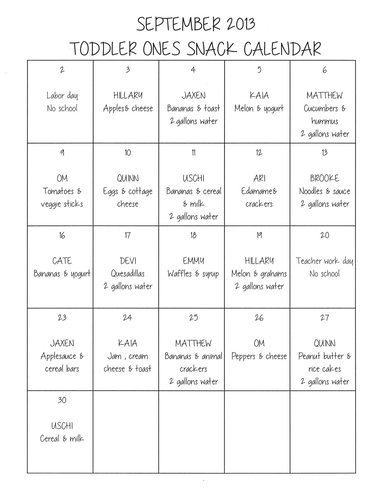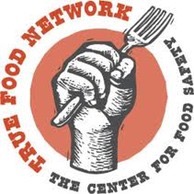
SNACK TIME IS
• a social experience with new opportunities to experiment with food through the five senses: touch, taste, smell, sight, and sound
• an important break in the day that nourishes and refuels the brain and the body in order to enhance the quality of learning
• a time to practice autonomy, self help, manners and social skills
• a chance to share food with friends family style
ALL CHILDREN ARE
• expected to come to the table during snack time
• served food and encouraged to try but not forced to eat or taste
• not required to eat or drink anything if they so choose
• expected to take a break from academic work
SNACK CALENDAR snack shopping guide
In all classes except the 1st/2nd and 3rd/4th grades, families take turns bringing the snack for the whole class. Teachers post a snack calendar for each month on their classroom websites. Here is a sample calendar:

Per health department regulations, two food groups must be included in each snack. Water will be served with snack. Often a child’s snack day includes a special sharing, having special jobs (e.g. being the line leader), or other types of recognition.
Students in the 1st/2nd and 3rd/4th grades bring their own snacks along with their lunches.
SNACK GUIDELINES
The Seed has always had a wholesome foods policy. With the changes in foods available, we find that we need to be more specific about our guidelines. Please keep in mind that these are GUIDELINES to which we hope all families will adhere. If for some reason you have difficulty following these guidelines, just do your best. When you purchase snacks, please read labels and avoid the following:
• high fructose corn syrup
• genetically modified organisms (GMO)***
• food dyes that include a number
• nitrates
GMO FOODS***

There is considerable controversy around GMOs. As a staff we continue to inform ourselves about the pros and cons of genetic modification with food. We are concerned about feeding foods to children that contain pesticides. One of the best ways to avoid pesticide ingestion through food is to buy organic or shop from the “clean fifteen” list (http://www.ewg.org/foodnews/summary.php) Certified organic products are not allowed to contain GMOs. The most common genetically modified ingredients in processed food are:
• corn (corn flour, modified food starch, fructose, dextrose, glucose)
• soy (soy flour, lecithin, protein, isolate, isoflavone, vegetable oil, vegetable protein)
• canola (canola oil, also called rapeseed oil)
• cotton (cottonseed oil)
Here are some excellent links for mindful shopping:
http://truefoodnow.files.wordpress.com/2011/02/cfs-shoppers-guide.pdf
There is also a phone app with this same information:
https://itunes.apple.com/app/true-food/id379459607?mt=8
PLACES TO SHOP
One of our goals for this website and our nutrition program at the Seed is to give parents suggestions for eating well without spending a fortune. Even mainstream grocery stores carry many organic items. Here are a few places that carry a varied line of non-GMO/organic products:
local farmers’ markets
Fry’s
Safeway
Costco
Sprouts
Trader Joe’s
Whole Foods
SNACK IDEAS
http://littlepageturners.blogspot.com/2010/04/edible-insects.html
